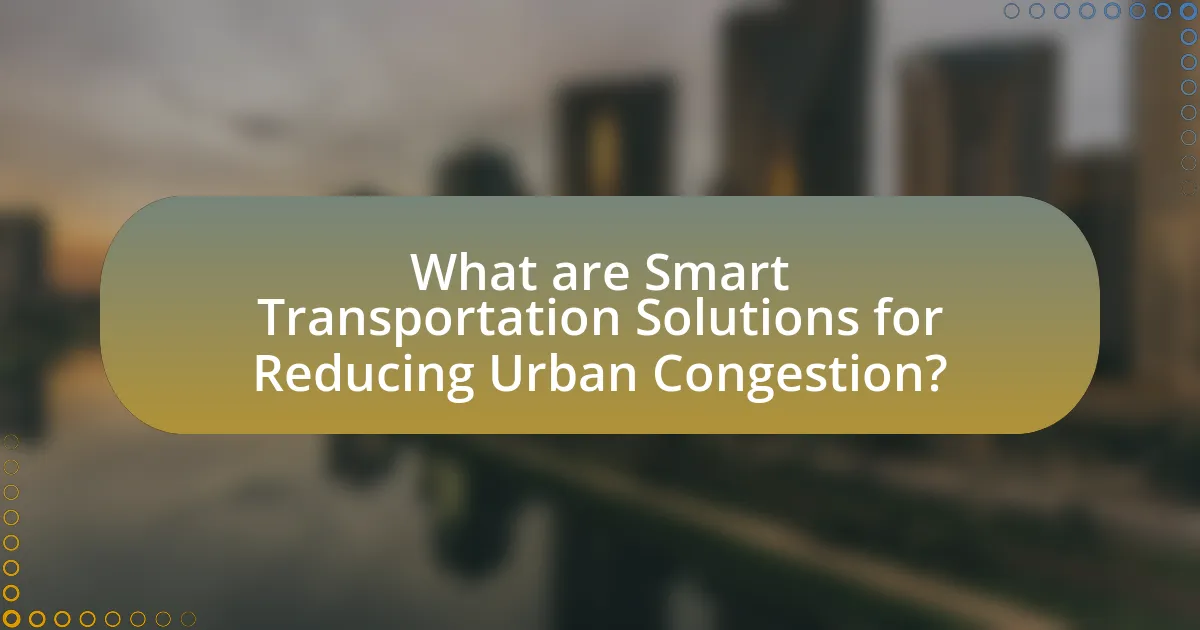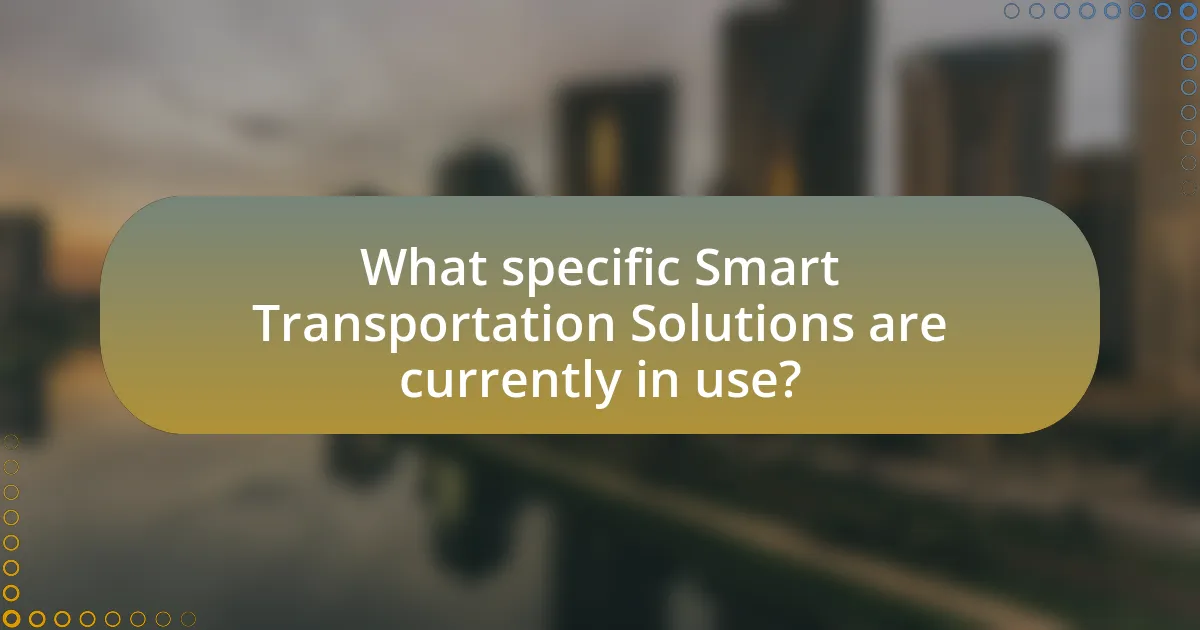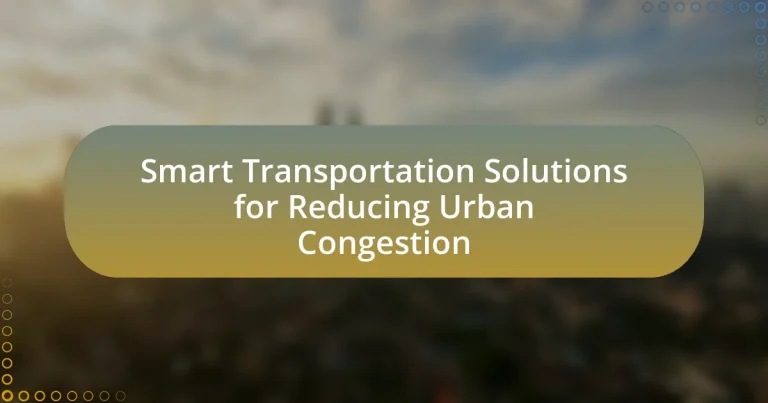Smart transportation solutions are advanced technologies designed to reduce urban congestion through improved traffic management and public transit efficiency. Key components include intelligent traffic management systems that utilize data analytics to optimize traffic flow, real-time public transit tracking that enhances ridership, and integrated mobility platforms that combine various transportation modes into a single application. These solutions leverage technologies such as the Internet of Things (IoT), artificial intelligence (AI), and big data analytics to streamline urban mobility, decrease travel times, and lower greenhouse gas emissions. The article also addresses the challenges cities face in implementing these solutions, the financial implications, and the importance of public perception and stakeholder engagement in fostering acceptance and successful adoption.

What are Smart Transportation Solutions for Reducing Urban Congestion?
Smart transportation solutions for reducing urban congestion include intelligent traffic management systems, real-time public transit tracking, and integrated mobility platforms. Intelligent traffic management systems utilize data analytics and machine learning to optimize traffic flow, reducing delays by up to 30% in some cities. Real-time public transit tracking enhances the efficiency of public transport by providing users with accurate arrival times, which can increase ridership by 20%. Integrated mobility platforms combine various transportation modes, such as ride-sharing, biking, and public transit, into a single app, promoting seamless travel and reducing reliance on personal vehicles. These solutions collectively contribute to decreased congestion, improved air quality, and enhanced urban mobility.
How do Smart Transportation Solutions address urban congestion?
Smart Transportation Solutions address urban congestion by utilizing advanced technologies to optimize traffic flow and enhance public transportation efficiency. These solutions include real-time traffic monitoring, adaptive traffic signal control, and integrated public transit systems, which collectively reduce travel times and improve overall mobility. For instance, cities implementing smart traffic signals can reduce congestion by up to 30% by adjusting signal timings based on real-time traffic conditions. Additionally, the use of mobile applications for public transit can increase ridership and decrease the number of vehicles on the road, further alleviating congestion.
What technologies are involved in Smart Transportation Solutions?
Smart Transportation Solutions involve technologies such as Internet of Things (IoT), artificial intelligence (AI), big data analytics, and connected vehicles. IoT enables real-time data collection from various transportation systems, while AI processes this data to optimize traffic flow and improve decision-making. Big data analytics helps in understanding traffic patterns and predicting congestion, and connected vehicles communicate with each other and infrastructure to enhance safety and efficiency. These technologies collectively contribute to reducing urban congestion by streamlining transportation systems and improving overall mobility.
How do these technologies integrate with existing urban infrastructure?
Smart transportation technologies integrate with existing urban infrastructure by utilizing data analytics, IoT devices, and communication networks to enhance traffic management and optimize resource allocation. For instance, smart traffic signals can adapt in real-time to traffic conditions, reducing congestion and improving flow. According to a study by the Institute of Transportation Engineers, cities implementing adaptive traffic signal control systems have reported a 10-30% reduction in travel times. Additionally, connected vehicles communicate with infrastructure to provide real-time updates, allowing for better route planning and reduced delays. This integration not only improves efficiency but also supports sustainable urban mobility initiatives.
What are the key benefits of implementing Smart Transportation Solutions?
Implementing Smart Transportation Solutions significantly enhances urban mobility, reduces congestion, and improves overall efficiency. These solutions utilize advanced technologies such as real-time data analytics, traffic management systems, and connected vehicles to optimize transportation networks. For instance, cities that have adopted smart traffic signals have reported a reduction in travel time by up to 20%, as these systems adapt to real-time traffic conditions. Additionally, smart transportation solutions can lead to a decrease in greenhouse gas emissions by promoting more efficient routes and reducing idle times, contributing to environmental sustainability. Furthermore, the integration of public transportation with smart technologies has been shown to increase ridership by 15%, as it provides users with better information and convenience.
How do these solutions improve traffic flow and reduce travel time?
Smart transportation solutions improve traffic flow and reduce travel time by utilizing real-time data analytics, adaptive traffic signal control, and integrated transportation systems. These technologies optimize traffic patterns by adjusting signal timings based on current traffic conditions, which can reduce stop-and-go traffic and minimize delays. For instance, studies have shown that adaptive traffic signals can improve traffic flow by up to 30%, leading to significant reductions in travel time. Additionally, real-time data from connected vehicles and infrastructure allows for better route planning and congestion management, further enhancing overall efficiency on urban roadways.
What environmental impacts do Smart Transportation Solutions have?
Smart Transportation Solutions significantly reduce greenhouse gas emissions and improve air quality. By optimizing traffic flow and promoting the use of public transportation, these solutions decrease reliance on personal vehicles, which are major contributors to urban pollution. For instance, studies indicate that implementing smart traffic management systems can reduce vehicle emissions by up to 30%. Additionally, the integration of electric and shared mobility options further minimizes the carbon footprint associated with urban transportation.

What challenges do cities face in adopting Smart Transportation Solutions?
Cities face several challenges in adopting Smart Transportation Solutions, including high implementation costs, data privacy concerns, and the need for infrastructure upgrades. High costs can deter investment, as cities must allocate significant budgets for technology and systems integration. Data privacy concerns arise from the collection and use of personal information, leading to public resistance and regulatory hurdles. Additionally, existing infrastructure may require substantial modifications to accommodate new technologies, complicating the transition process. These challenges hinder the effective implementation of smart transportation initiatives aimed at reducing urban congestion.
What are the financial implications of implementing these solutions?
Implementing smart transportation solutions for reducing urban congestion can lead to significant financial implications, including cost savings and increased economic productivity. For instance, cities that adopt intelligent traffic management systems can reduce congestion-related costs by up to 30%, as evidenced by a study from the Texas A&M Transportation Institute, which found that congestion costs U.S. drivers approximately $166 billion annually in wasted time and fuel. Additionally, investments in smart public transit can yield a return of $4 for every $1 spent, according to the American Public Transportation Association, highlighting the potential for enhanced economic activity and job creation. Overall, the financial benefits of these solutions can outweigh the initial implementation costs, leading to long-term savings and economic growth.
How can cities secure funding for Smart Transportation initiatives?
Cities can secure funding for Smart Transportation initiatives by leveraging a combination of federal grants, public-private partnerships, and innovative financing mechanisms. For instance, the U.S. Department of Transportation offers various grant programs, such as the Better Utilizing Investments to Leverage Development (BUILD) program, which allocated $1 billion in 2020 to support infrastructure projects, including smart transportation solutions. Additionally, cities can collaborate with private companies to share costs and resources, as seen in successful partnerships like those between municipalities and tech firms for smart traffic management systems. Furthermore, cities can explore financing options such as green bonds, which have gained popularity for funding sustainable projects, with the global green bond market reaching over $1 trillion in issuance by 2021. These strategies collectively enhance the financial viability of smart transportation initiatives, enabling cities to reduce urban congestion effectively.
What are the potential costs associated with technology upgrades?
The potential costs associated with technology upgrades in smart transportation solutions include hardware expenses, software licensing fees, installation and integration costs, ongoing maintenance, and training for personnel. Hardware expenses can range from purchasing sensors and communication devices to upgrading existing infrastructure, often totaling thousands to millions of dollars depending on the scale of the project. Software licensing fees may involve costs for proprietary systems or platforms that facilitate data analysis and traffic management. Installation and integration costs arise from the need to incorporate new technology into existing systems, which can be complex and labor-intensive. Ongoing maintenance is necessary to ensure the technology operates effectively, which can incur additional costs over time. Finally, training personnel to effectively use and manage the new technology is crucial, adding to the overall investment required for successful upgrades.
How do public perceptions affect the adoption of Smart Transportation Solutions?
Public perceptions significantly influence the adoption of Smart Transportation Solutions by shaping user acceptance and trust in these technologies. When the public views smart transportation as beneficial, safe, and reliable, they are more likely to embrace its implementation. For instance, a survey conducted by the American Public Transportation Association found that 70% of respondents expressed a positive attitude towards smart transit technologies, indicating a strong correlation between favorable perceptions and willingness to adopt such solutions. Conversely, negative perceptions, often stemming from concerns about privacy, data security, and the reliability of technology, can hinder adoption rates. Therefore, addressing public concerns and enhancing awareness through education and outreach can facilitate greater acceptance of smart transportation initiatives.
What strategies can be used to educate the public about these solutions?
To educate the public about smart transportation solutions for reducing urban congestion, targeted awareness campaigns utilizing social media, community workshops, and partnerships with local organizations are effective strategies. Social media platforms can disseminate information quickly, reaching a broad audience; for instance, cities like San Francisco have successfully used Twitter and Facebook to promote public transit initiatives. Community workshops allow for direct engagement, enabling residents to ask questions and understand the benefits of smart solutions, as demonstrated by initiatives in cities like Seattle, where local forums increased public participation in transit planning. Collaborating with local organizations, such as schools and businesses, can further amplify outreach efforts, as seen in Chicago’s partnerships that integrated transportation education into community events. These strategies collectively enhance public understanding and acceptance of smart transportation solutions.
How can stakeholder engagement improve acceptance of Smart Transportation Solutions?
Stakeholder engagement can significantly improve the acceptance of Smart Transportation Solutions by fostering collaboration and addressing concerns directly. Engaging stakeholders, such as local communities, government agencies, and transportation providers, allows for the identification of specific needs and preferences, which can lead to tailored solutions that resonate with users. For instance, a study by the Transportation Research Board found that projects involving stakeholder input had a 30% higher acceptance rate compared to those that did not engage stakeholders. This engagement builds trust, enhances transparency, and encourages a sense of ownership among stakeholders, ultimately leading to greater support for the implementation of smart transportation initiatives.

What specific Smart Transportation Solutions are currently in use?
Smart transportation solutions currently in use include intelligent traffic management systems, real-time public transit tracking, and connected vehicle technologies. Intelligent traffic management systems utilize sensors and algorithms to optimize traffic flow, reducing congestion by up to 30% in some urban areas. Real-time public transit tracking applications provide users with live updates on bus and train schedules, improving efficiency and encouraging public transport use. Connected vehicle technologies enable vehicles to communicate with each other and infrastructure, enhancing safety and reducing traffic delays. These solutions are supported by various studies, such as the U.S. Department of Transportation’s findings, which highlight significant improvements in urban mobility through the implementation of these technologies.
What role do traffic management systems play in urban congestion reduction?
Traffic management systems play a crucial role in urban congestion reduction by optimizing traffic flow and minimizing delays. These systems utilize real-time data from various sources, such as sensors and cameras, to monitor traffic conditions and adjust signal timings accordingly. For instance, studies have shown that adaptive traffic signal control can reduce delays by up to 30%, significantly improving overall traffic efficiency. Additionally, traffic management systems can provide drivers with real-time information about congestion and alternative routes, further alleviating bottlenecks. By implementing these technologies, cities can enhance mobility and reduce the environmental impact associated with traffic congestion.
How do adaptive traffic signals enhance traffic flow?
Adaptive traffic signals enhance traffic flow by dynamically adjusting signal timings based on real-time traffic conditions. This technology utilizes sensors and algorithms to monitor vehicle density and movement, allowing signals to optimize green light durations and reduce wait times at intersections. Studies have shown that cities implementing adaptive traffic signal systems can experience a reduction in travel time by up to 25% and a decrease in vehicle stops by approximately 30%, leading to improved overall traffic efficiency.
What data analytics tools are used to optimize transportation networks?
Data analytics tools used to optimize transportation networks include Geographic Information Systems (GIS), predictive analytics software, and traffic simulation models. GIS enables the visualization and analysis of spatial data, helping planners identify congestion patterns and optimize routes. Predictive analytics software utilizes historical data to forecast traffic trends and demand, allowing for proactive adjustments in transportation planning. Traffic simulation models, such as VISSIM and AIMSUN, simulate traffic flow and assess the impact of various scenarios on network performance, providing insights for effective decision-making. These tools collectively enhance the efficiency and effectiveness of transportation systems, contributing to reduced urban congestion.
How do ride-sharing and micro-mobility solutions contribute to reducing congestion?
Ride-sharing and micro-mobility solutions significantly reduce congestion by optimizing vehicle usage and decreasing the number of single-occupancy vehicles on the road. Ride-sharing platforms, such as Uber and Lyft, facilitate carpooling, allowing multiple passengers to share a ride, which leads to fewer cars on the road. A study by the University of California, Davis, found that ride-sharing services can reduce vehicle miles traveled by up to 10% in urban areas.
Micro-mobility options, including e-scooters and bicycles, provide alternatives for short trips, further decreasing reliance on cars. According to a report from the National Association of City Transportation Officials, cities that have integrated micro-mobility solutions have seen a reduction in traffic congestion by as much as 20% during peak hours. Together, these solutions enhance urban mobility, promote efficient transportation, and contribute to a decrease in overall traffic congestion.
What are the benefits of integrating ride-sharing services with public transport?
Integrating ride-sharing services with public transport enhances urban mobility by providing seamless connectivity and reducing congestion. This integration allows users to easily transition between different modes of transport, thereby increasing the overall efficiency of the transportation system. For instance, a study by the University of California, Berkeley, found that integrating ride-sharing with public transit can reduce vehicle miles traveled by up to 10%, leading to decreased traffic congestion and lower emissions. Furthermore, it improves accessibility for underserved areas, ensuring that more residents can access public transport options.
How do e-scooters and bike-sharing programs alleviate urban traffic issues?
E-scooters and bike-sharing programs alleviate urban traffic issues by providing convenient, flexible alternatives to traditional car travel. These modes of transportation reduce the number of vehicles on the road, thereby decreasing congestion. For instance, a study by the National Association of City Transportation Officials found that bike-sharing programs can lead to a 10% reduction in car trips in urban areas. Additionally, e-scooters offer a quick and efficient way to cover short distances, which further encourages people to opt for these options instead of driving. This shift not only eases traffic but also contributes to lower emissions and improved air quality in cities.
What best practices can cities adopt for successful implementation of Smart Transportation Solutions?
Cities can adopt several best practices for the successful implementation of Smart Transportation Solutions, including integrating data analytics, fostering public-private partnerships, and ensuring community engagement. Integrating data analytics allows cities to collect and analyze real-time traffic data, which can optimize traffic flow and reduce congestion. For instance, cities like Los Angeles have implemented adaptive traffic signal control systems that adjust signal timings based on real-time traffic conditions, leading to a reported 20% reduction in travel times.
Fostering public-private partnerships encourages collaboration between government entities and technology providers, facilitating the development and deployment of innovative solutions. For example, partnerships in cities like Singapore have led to the successful implementation of smart parking systems that utilize sensors to provide real-time availability information, reducing the time drivers spend searching for parking.
Ensuring community engagement is crucial for gaining public support and understanding user needs. Cities such as Barcelona have conducted workshops and surveys to involve residents in the planning process, resulting in solutions that are more aligned with community expectations and usage patterns. These practices collectively enhance the effectiveness of Smart Transportation Solutions, ultimately contributing to reduced urban congestion.
How can cities create a comprehensive Smart Transportation strategy?
Cities can create a comprehensive Smart Transportation strategy by integrating advanced technologies, data analytics, and stakeholder collaboration to enhance mobility and reduce congestion. This involves implementing intelligent traffic management systems that utilize real-time data to optimize traffic flow, as evidenced by cities like Los Angeles, which reported a 20% reduction in congestion through adaptive traffic signals. Additionally, cities should promote multimodal transportation options, including public transit, cycling, and ridesharing, to provide residents with diverse travel choices. The use of mobile applications for real-time transit updates and route planning can further improve user experience and encourage public transport usage. Engaging with local communities and businesses in the planning process ensures that the strategy meets the specific needs of the population, fostering greater acceptance and participation.
What role does continuous evaluation play in the success of these solutions?
Continuous evaluation is crucial for the success of smart transportation solutions aimed at reducing urban congestion. It allows for real-time assessment of system performance, enabling timely adjustments and improvements based on data-driven insights. For instance, cities that implement continuous evaluation can analyze traffic patterns and user behavior, leading to optimized traffic signal timings and better route planning. Research indicates that cities employing continuous evaluation methods have seen up to a 30% reduction in congestion levels, demonstrating the effectiveness of this approach in enhancing transportation efficiency.


